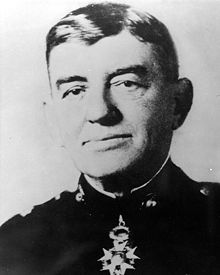John A. Lejeune

John Archer Lejeune (born January 10, 1867 in Pointe Coupee Parish , Louisiana , † November 20, 1942 in Baltimore , Maryland ) was an American officer in the United States Marine Corps , most recently Lieutenant General , and 13th Commandant of the Marine Corps from 1920 to 1929.
Life
Lejeune was the son of the former Captain of the Confederate States Army , Ovide Lejeune, on the Old Hickory Plantation at Lacour born in rural Louisiana. He was educated at a boarding school at Natchez and entered Louisiana State University in Baton Rouge as a cadet in 1881 , where he spent the next three years. The high cost of education at LSU forced the family to find an alternative, and Congressman Edward T. Lewis enabled him to take the entrance exam for the United States Naval Academy in Annapolis in 1884 . He was accepted and graduated four years later as one of 32 graduates with the rank of midshipman . His first command led him to the screw corvette USS Mohican . In early 1889 he was on the USS Vandalia , which was sent to the Samoa Islands ( conflict over Samoa ), when it was badly damaged in a cyclone. Transferred to the USS Adams , which had arrived for relief , he returned to Annapolis in 1890. He had made a resolution not to pursue the career of a naval officer but to join the Marine Corps.
In July 1890 he was inducted into the USMC as 2nd Lieutenant . After a brief training and indoctrination, he was assigned to the Norfolk Naval Base . He served aboard the gunboat USS Bennington from 1891 to 1893 and was promoted to 1st Lieutenant in 1892 . He then served in the Norfolk Barracks until 1897. In 1897 he became the commander of the naval detachment aboard the protected cruiser USS Cincinnati , with which he participated in the Spanish-American War of 1898. He served aboard the battleship USS Massachusetts from 1899 to 1900 and was promoted to captain in March 1899. After serving as a recruiting officer, he was appointed commandant of the Marine Barracks in Pensacola , Florida in late 1900 . He later served again in Norfolk and at the Marine Corps Headquarters in Washington, DC From 1903 to 1904 he served with the rank of major on the Isthmus of Panama , in what would later become the Panama Canal Zone . This was followed by periods of service in the Marine Barracks Washington and again in Panama until 1907, when he was transferred to the Philippines . Here he served in Cavite Province until he was called to the United States Army War College in 1909 for a year-long course . Lejeune, now promoted to Lieutenant Colonel , spent the following years at the Guantanamo Bay Naval Base in Cuba and Panama. In 1914 he took part in the occupation of Veracruz , Mexico , just promoted to colonel . After returning to the States, he became assistant to Marine Corps Commander George Barnett in Washington, whom he would later succeed, and was promoted to Brigadier General in the summer of 1916 .
After the USA entered the First World War in April 1917, he took command of the newly founded Marine Corps Base Quantico . In June of the following year he was sent to the front in France, where he initially led a brigade of the 32nd Infantry Division . After a short time he took over command of the 4th Marine Brigade, which was part of the 2nd Infantry Division , and finally, in July 1918, of the 2nd Infantry Division. He was the first officer in the Marines in such a post. With his division, Lejeune took part in the battle of St. Mihiel and the Meuse-Argonne offensive in autumn 1918 . After the armistice , the division took part in the occupation of the Rhineland , Lejeune remained its commander until August 1919. Among other awards, he received the Army Distinguished Service Medal and the Navy Distinguished Service Medal after the war .
After returning to the United States, Lejeune was again in command of Quantico and was appointed to succeed General Barnett as Commandant of the Marine Corps in July 1920. He served in this post until 1929 when he was retired. In retirement, he served as superintendent of the Virginia Military Institute until his deteriorating health forced him to resign in 1937. In early 1942 he was promoted to lieutenant general on the retired list .
Lejeune was a co-founder of the Marine Corps League , founded in 1923 , which received its official statutes from the US Congress in 1937. Since 1930 he was an honorary member of the Society of the Cincinnati . He died in November 1942 at the age of 75 in a hospital in Baltimore and was buried with military honors in Arlington National Cemetery . The Marine Corps Base Camp Lejeune was named after him.
literature
- Merrill L. Bartlett: Lejeune: A Marine's Life, 1867-1942. Naval Institute Press, 1996, ISBN 0-87249-771-2 .
Web links
- John Archer Lejeune at arlingtoncemetery.net
- John A. Lejeune in the database of Find a Grave (English)
| personal data | |
|---|---|
| SURNAME | Lejeune, John A. |
| ALTERNATIVE NAMES | Lejeune, John Archer (full name) |
| BRIEF DESCRIPTION | U.S. Lieutenant General, 13th Commandant of the Marine Corps |
| DATE OF BIRTH | January 10, 1867 |
| PLACE OF BIRTH | Pointe Coupee Parish , Louisiana |
| DATE OF DEATH | November 20, 1942 |
| Place of death | Baltimore , Maryland |